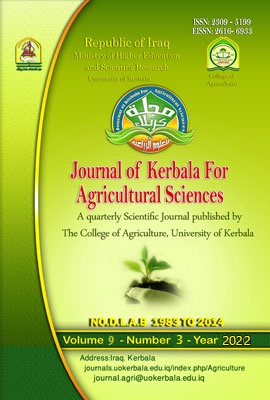Identification and determination of some fatty acid compounds and free phenolics from the seeds of Cuminum cyminum L. plant growing in Iraq
DOI:
https://doi.org/10.59658/jkas.v9i3.994Keywords:
Cuminum Cyminum, fatty acids, saponification, phenolicsAbstract
The current research aims at the separation and identification of many fatty acid compounds from the seeds of cuminum cyminum L. that are grown in Iraq using a continuous soxhelt extractor and sequence solvent systems depending on the polarity, Pet-ether extract (CUI), chloroform extract (CU2), ethyl acetate extract (CU3) and ethanolic extract (CU4). Hot aqueous extracts (CU5) and saponification processes were also used to liberate the free pool of fatty acid compounds; (Palmatic, stearic, Linoleic, α - Linolenic and Oleic acids). The increasing of concentration of fatty acids was cleared from CU5à CU1 as a result of decreasing of the polarity. In addition to that, the extracts (CU3, Cu4 and Cu5) were carried out by the acid hydrolysis to obtain the free phenolic compounds, which were identified by means of using HPLC technique. The phenolic compounds, which were presented in the seeds of Cuminum cyminum L. were: (Apigenin, Gallic acid, Syringic acid, Vanillic acid, Rutin, Quercetin, Kaempferol and P-coumaric acid .Apigenin, Gallic acid and Syringic acid were appeared in the extracts (CU3, CU4 and CU5). Moreover, the Vanillic acid compound was presented in CU3 and CU4, Rutin and Quercetin were also presented in CU3 and CU5. Also the Kaempferol, it was presented only in CU4. Finally, P-Coumaric acid was identified only in CU5.
Downloads
Published
How to Cite
Issue
Section
License
Copyright (c) 2022 Copyright (c) 2024 is the Author's article. Published by the Journal of Kerbala for Agricultural Sciences under a CC BY 4.0 license

This work is licensed under a Creative Commons Attribution 4.0 International License.
Licensing Terms
All articles are published under a Creative Commons License and will be directed to the Creative Commons Attribution 4.0 International License (CC BY 4.0) That permits use, distribution, and reproduction in any medium, provided the original work is properly cited. This license also allows the work to be used for commercial purposes.
Use by both non-commercial and commercial users
This content is licensed under a Creative Commons Attribution 4.0 International (CC BY 4.0) license, permitting use by both non-commercial and commercial users. Individual users may access, download, copy, display, and redistribute the articles to colleagues, as well as adapt, translate, and text- and data-mine the content, subject to the following conditions:
- The author's moral rights, including the right of attribution and the right to protect their work from derogatory treatment, are respected.
- Where content in the article is identified as belonging to a third party, users must ensure that any reuse complies with the copyright policies of the owner of that content.
- If the article content is reused for research or educational purposes, users should maintain a link to the appropriate bibliographic citation, including the DOI and a link to the published version on the journal's website.






